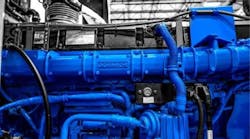Case study: Disaster preparedness begins with reliable power
In February 2021, frigid temperatures brought chaos to roads and wreaked havoc on Texas energy infrastructure. The winter storm left millions of residents without power and thousands of businesses unable to operate. But the important work conducted at AmerisourceBergen continued.
The wholesale pharmaceutical company, which distributes pharmaceutical products to tens of thousands of care sites nationwide each day, kept operations humming with a microgrid at the company’s Carrollton, Texas, 300,000 square foot facility as winds blew, snow fell and ice covered the terrain outside.
It’s essential to expect the unexpected when mission-critical operations depend on power because there is a never-ending source of natural disasters. A microgrid can deliver critical power during all of them, be it hurricane season in the south, wildfires in the west or deep freezes in the north.
Company never loses power during unexpected winter storm
AmerisourceBergen’s Carrollton, Texas, facility holds a pharmacy that stores pharmaceuticals used by patients undergoing a specialized treatment regimen. Before the facility opened in 2019, company leaders recognized that it needed a reliable power source to protect these critical lifesaving medications if the power grid went down. They just hoped they’d never have to use it.
“The compounds for these formulas are temperature and light sensitive, and must be kept in a very stable environment,” explained Kelly Land, business development manager at PowerSecure, a provider of advanced microgrids. “A reliable energy source is a critical piece of creating that stable environment.”
AmerisourceBergen partnered with PowerSecure to protect its Texas location through a long-term contract to provide energy-as-a-service to the entire facility when there is a utility outage. PowerSecure designed, constructed, owns, operates and maintains the 2,500-kW PowerBlock® system that relies on four Volvo Penta 16-liter Tier 4 Final engines as the prime mover, or energy source.
In addition to providing full facility backup during an emergency event, Volvo Penta’s Environmental Protection Agency Tier 4 Final classification also enabled the PowerBlock® system to receive a permit to run for nonemergency purposes, such as participation in highly incentivized demand response programs. During demand response events, the PowerSecure system helps relieve grid stress by removing the AmerisourceBergen facility’s electrical load, and, in some cases, it even exports excess power onto the grid. Participation in these programs produces utility savings and guaranteed revenue throughout the year, and, more importantly, it benefits the community by helping maintain the stability of a shared electricity grid.
Initially, during the February storm, the grid operators called on generation assets — such as the AmerisourceBergen microgrid — enrolled in demand response programs to run to remove load from grid. But as the storm raged on, frequency began to dip and grid operators responded by initiating rolling outages. At that point, the AmerisourceBergen system transitioned from running in parallel operation to island mode, opting to rely on its microgrid for power.
“We mirror grid conditions when operating in long-term parallel, but we got to a point where it was dangerous for the system to continue doing that,” Land explained. “When we saw voltage dip from 60 hertz to 59.4 hertz, we decoupled from the grid and went to generator power in island mode. We continued that off and on for five days through rolling outages.”
“With us, resiliency for our customers is always the priority, and the microgrid operated reliably for the duration of the storm,” Land added. “AmerisourceBergen didn’t lose any specialty pharmaceuticals. They were able to store and distribute the pharmaceutical products to health care providers across the country, enabling patients to receive the treatment they need because even though there was a storm, their need for them never stopped,” he said.
Robust and reliable engine power
A microgrid used to provide power during a natural disaster must be robust and reliable. Land attributes the AmerisourceBergen microgrid’s ability to provide power during the winter storm to its Volvo Penta engines.
Volvo Penta engines offer significant reliability. “The engines offer 99.5% reliability, which is far above industry standards for microgrid technology,” Land said.
PowerSecure places up to six gensets in a single package to provide 3.7 MW of power. The Volvo Penta engines handle block loading situations with ease. “Our multi-unit PowerBlocks ramp and parallel so quickly that they operate as if they are a single unit,” Land said. “If one engine trips, the remaining Volvo Penta engines typically have enough capacity to continue to serve the facility’s load.”
Volvo Penta engines are the only diesel fuel, renewable-ready engines PowerSecure uses for microgrids designed to power mission-critical operations during natural disasters. The industry recognizes Volvo Penta diesel engines for their ultra-low emissions and high reliability, Land said, and the company itself for its innovations.
“Volvo Penta is constantly ahead of the curve,” Land said. “We know we don’t have to worry about how they will handle renewable fuels; they’re already working on it. We don’t have to think about the next emissions class as the world continues to decarbonize because we know Volvo Penta is already thinking about Tier 5 technology. They are always innovating for the energy solutions of the future.”
